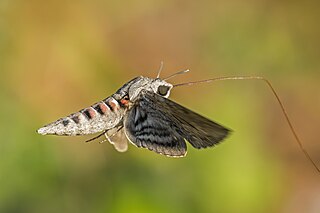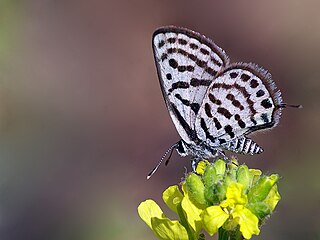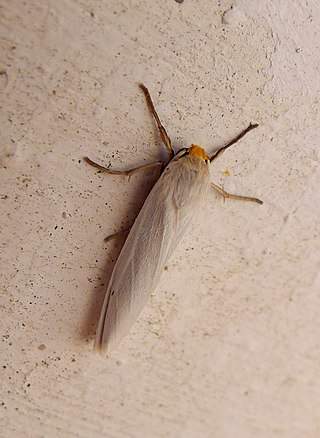
Lymantria dispar, also known as the gypsy moth or the spongy moth, is a species of moth in the family Erebidae native to Europe and Asia. Lymantria dispar is subdivided into several subspecies, with subspecies such as L. d. dispar and L. d. japonica being clearly identifiable without ambiguity. Lymantria dispar has been introduced to several continents and is now additionally found as an invasive species in Africa, North America and South America. The polyphagous larvae live on a variety of deciduous and coniferous trees and can cause severe damage in years of mass reproduction. Due to these features, Lymantria dispar is listed among the world's 100 worst invasive alien species.

Prunus spinosa, called blackthorn or sloe, is a species of flowering plant in the rose family Rosaceae. The species is native to Europe, western Asia, and regionally in northwest Africa. It is locally naturalized in New Zealand, Tasmania, and the Pacific Northwest and New England regions of the United States.

The Pyralidae, commonly called pyralid moths, snout moths or grass moths, are a family of Lepidoptera in the ditrysian superfamily Pyraloidea. In many classifications, the grass moths (Crambidae) are included in the Pyralidae as a subfamily, making the combined group one of the largest families in the Lepidoptera. The latest review by Eugene G. Munroe and Maria Alma Solis retain the Crambidae as a full family of Pyraloidea.

The Uzbekistan national football team represents Uzbekistan in international football and is controlled by the Uzbekistan Football Association, the governing body for football in Uzbekistan.

The Lymantriinae are a subfamily of moths of the family Erebidae. The taxon was erected by George Hampson in 1893.

The setaceous Hebrew character is a moth of the family Noctuidae. The species was first described by Carl Linnaeus in his 1758 10th edition of Systema Naturae. It is found in the Palearctic realm. It is a common species throughout Europe and North Asia and Central Asia, South Asia, China, Japan and Korea. It is also found in North America, from coast to coast across Canada and the northern United States to western Alaska. It occurs in the Rocky Mountains from Montana to southern Arizona and New Mexico. In the east, it ranges from Maine to North Carolina. It has recently been recorded in Tennessee.

Agrius convolvuli, the convolvulus hawk-moth, is a large hawk-moth. It is common throughout Europe, Asia, Africa, Australia and New Zealand, partly as a migrant. In New Zealand, it is also known as the kumara moth, and in the Māori language as hīhue.

Tarucus balkanicus, the Balkan Pierrot or little tiger blue, is a small butterfly that belongs to the lycaenids or blues family. It is found in Mauritania, Niger, Sudan (Khartoum), Uganda, Saudi Arabia, the United Arab Emirates, Oman, North Africa, the Balkans, western Asia, parts of central Asia and in India. The habitat consists of very arid savanna.

Arctia festiva, the hebe tiger moth, is a moth species of the family Erebidae. Some authors have separated it in a monotypic genus Eucharia. It is found in Central and Southern Europe, Near East, Iran, Central Asia, European Russia, Southern Siberia, Mongolia and China.

Manulea palliatella is a moth of the family Erebidae. It is found in southern, central and eastern Europe, Asia Minor, Iran, Afghanistan, Central Asia, Kazakhstan.

Deilephila porcellus, the small elephant hawk-moth, is a moth of the family Sphingidae. The species was first described by Carl Linnaeus in his 1758 10th edition of Systema Naturae.

Sphinx morio, the larch hawk moth or Asian pine hawkmoth, is a moth of the family Sphingidae. It is found in Russia, the Korean Peninsula, Japan and China.

Moth ki Mosque is a heritage building located in Delhi, and was built in 1505 by Wazir Miya Bhoiya, Prime Minister during the reign of Sikander Lodi (1489–1517) of the Lodi dynasty. It was a new type of mosque developed by the Lodis in the fourth city of the medieval Delhi of the Delhi Sultanate. The name of the mosque literally translated into English language means ‘Lentil Mosque’ and this name tag ‘Lentil’ has an interesting legend. This mosque was considered a beautiful Dome (Gumbad) structure of the period.

Stephensia is a genus of the small and very small moths of the family Elachistidae.
Syncopacma polychromella is a moth of the family Gelechiidae, it was described by Hans Rebel in 1902.
Elachista phragmitella is a moth in the family Elachistidae. It was described by Sruoga in 1992. It is found in Central Asia.
Elachista bicingulella is a moth in the family Elachistidae. It was described by Sruoga in 1992. It is found in Central Asia.
Elachista grandiferella is a moth in the family Elachistidae. It was described by Sruoga in 1992. It is found in Central Asia.
Elachista vakshi is a moth in the family Elachistidae. It was described by Sruoga in 1992. It is found in Central Asia.
Stephensia jalmarella is a moth in the family Elachistidae. It was described by Lauri Kaila in 1992. It is found in the Altai Mountains.












